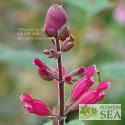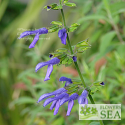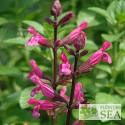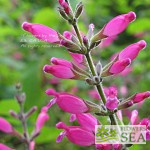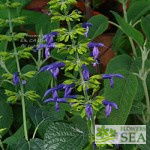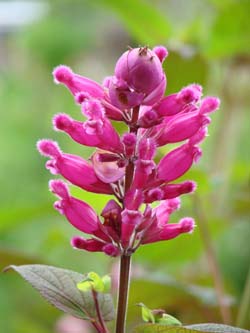(Boutin Roseleaf Sage) "Boutin" means "button" in French, and the creamy, mulberry pink flowers of Salvia involucrata 'Boutin' do look cute as buttons.
However, this cultivar most likely is named for former Huntington Gardens botanist Fred Boutin whose horticultural legacy includes hybridization of the popular Salvia guaranitica 'Purple Majesty'. Boutin is also an heirloom rose specialist, so it seems fitting that a Roseleaf Sage would be named for him.
In 1793, the species gained its scientific name from Antonio José Cavanilles, a Spanish cleric and tutor to the children of royalty as well as a self-taught botanist. Cavanilles served as director of the Royal Botanic Gardens of Madrid from 1801 until his death in 1804.
Involucrata is Latin and refers to pink, leaf-like bracts that protect the flower's petals. Bracts sometimes are difficult to differentiate from petals due to being the same color. However, Boutin Roseleaf Sage is notable for burgundy bracts and stems.
Despite this plant's common name, it isn't its heart-shaped leaves that remind the viewer of a rose. It's the tightly furled buds. That's why Rosebud Sage is another name for the species.
This is a subshrub, which means that it combines the soft herbaceous growth of a perennial with the woody growth of a shrub.
Similar to other sages in the Roseleaf group, Boutin grows well either in full sun or partial shade. Give it rich, well-drained soil similar to garden loam and average supplemental watering if local rainfall is insufficient. This is a water-loving sage and can be a solution -- as long as soil drainage is good -- for Salvia gardens where rainfall is plentiful.
Boutin Roseleaf Sage charms hummingbirds, but deer aren't attracted to it even if the yummy looking flowers are cute as rosebud buttons.
Question?

